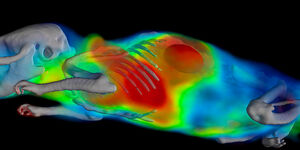

Ensuring Quantitative Accuracy in PET
Image quality is only one aspect of functional imaging with PET and SPECT. The ability to reproducibly extract quantitative information from our images is critical to research. This may be as simple as assessing tumor-to-background ratio in tracer development, or as complex as assessing treatment protocols in oncology models, or dosimetry for extrapolation to human applications. Scanners need to be properly maintained and used according to the manufacturer’s guidelines. The user can be directly supported with good quality control workflows and imaging protocols. In this webinar, NMI experts Geoff and Cesar will describe quality control procedures and image corrections for the Bruker PET technology, as well as showing image transfer to PMOD for accurate analysis. The QC protocols are easy and convenient to use. Reconstructed images are directly transferred or imported into PMOD, maintaining the important metadata and accuracy.
This webinar took place on April 22nd, 2020
What To Expect
Cesar will provide a basic level of understanding for anyone interested in the best practices to follow in scanner quality control for PET. Geoff will demonstrate how the accuracy of the data, and statistics generated, can be checked in PMOD as part of the image analysis workflow.
Key Learning Objectives
- The importance of QC for scanners: calibration, reconstruction, and corrections.
- PMOD’s software package for multimodality image analysis: data QC after loading or import, important aspects of segmentation and their effect on SUV, time-activity curves and kinetic modeling.
- Important PET/SPECT image formats and their metadata.
Who Should Attend?
This webinar will interest anyone working with pre-clinical PET and SPECT in industry and academia, including those with limited knowledge of the techniques. Post-grad students, technicians and principal investigators wanting to understand more about the techniques may find the webinar particularly useful.
Speakers
Geoff Warnock
Senior Application Scientist, pmod
Geoff Warnock is a Senior Application Scientist at pmod Technologies, part of Bruker since July 2019. pmod provides solutions for all stages of quantitative data processing, and specializes in PET kinetic modeling. Geoff has focused on quantitative PET for more than 10 years, and provides customized training courses to pmod’s customers around the world.
Cesar Molinos
Preclinical Imaging Applications Scientist, Bruker BioSpin
Cesar Molinos is a Preclinical Imaging Applications Scientist at Bruker. Cesar is a physicist and electronics engineer by training and has been working in preclinical imaging for over 10 years. After previous work developing gamma detectors for radio-guided surgery, he focuses on molecular imaging applications and development.